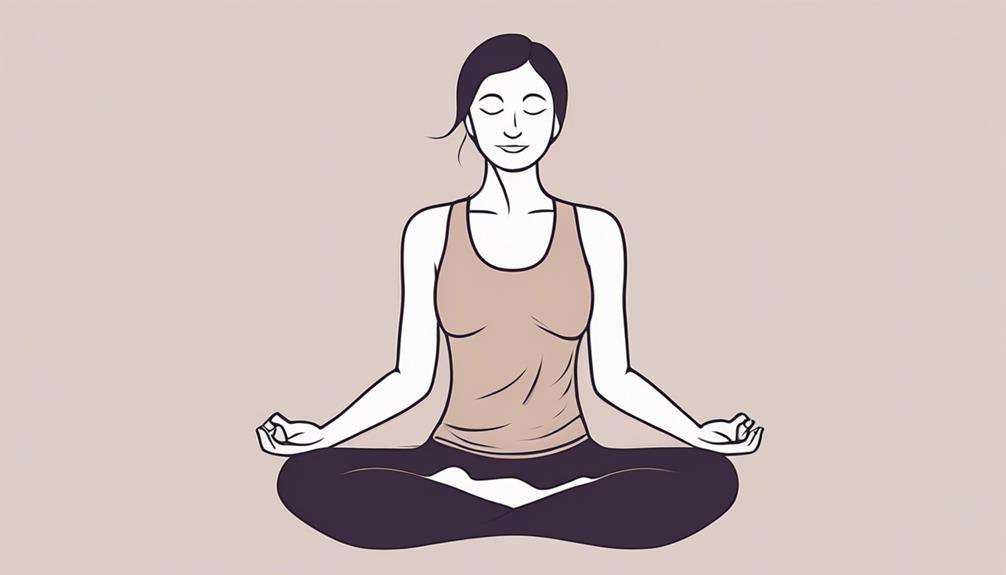When it comes to managing blood pressure naturally, understanding various breathing techniques can be quite beneficial.
You might be surprised to learn how simple adjustments in your breathing patterns can have a significant impact on your cardiovascular health.
By incorporating specific breathing exercises into your daily routine, you can potentially see positive changes in your blood pressure levels.
So, which breathing techniques are most effective in achieving this goal?
Let's explore some insightful strategies that could help you on your path to better blood pressure control.
Key Takeaways
- Pranayama and yoga breathing techniques effectively lower blood pressure naturally.
- Box breathing aids in stress reduction and heart rate regulation for better blood pressure control.
- Consistent practice of breathing exercises supports proactive blood pressure management.
- Deep breathing triggers relaxation responses, reducing hypertension effectively.
Benefits of Yoga Breathing for Blood Pressure
Yoga breathing techniques, such as Pranayama, actively reduce blood pressure by enhancing relaxation and calming the nervous system. This reduction in blood pressure is vital for maintaining overall cardiovascular health. By engaging in controlled breathing practices, individuals can improve heart rate variability, which plays a significant role in regulating blood pressure levels.
Lower stress levels achieved through regular practice of yoga breathing exercises further support the management of hypertension. Deep breathing in yoga not only promotes relaxation but also increases oxygen supply to the body. This boost in oxygen aids in enhancing overall health and assists in the regulation of blood pressure.
Incorporating yoga breathing into your daily routine can contribute to better blood pressure control, ultimately improving your well-being. Embracing these techniques can be a natural and effective way to support your cardiovascular health and manage blood pressure levels.
Understanding Box Breathing Technique
Utilizing a structured breathing pattern known as box breathing can aid in promoting relaxation and reducing stress levels, thereby potentially lowering blood pressure through calming the nervous system and enhancing parasympathetic activity.
Box breathing involves a simple yet effective pattern of inhaling, holding, exhaling, and holding for counts of four. By engaging in this technique, you enable your body to enter a state of relaxation, which can contribute to better blood pressure management.
The controlled nature of box breathing helps regulate your heart rate, reduce anxiety, and improve your ability to focus. This structured breathing pattern can be conveniently practiced anywhere and, when done for about five minutes daily, may lead to improved overall well-being.
Practicing Belly Breathing for Wellness

Incorporating belly breathing, also known as diaphragmatic breathing, into your daily routine can promote relaxation, decrease stress levels, and potentially lower blood pressure naturally. This technique involves engaging the diaphragm to allow deeper breaths, encouraging the belly to rise and fall with each breath.
By activating the body's relaxation response and reducing the 'fight-or-flight' reaction, belly breathing can help lower blood pressure. Extending the exhale to be twice as long as the inhale during belly breathing enhances oxygen exchange and improves lung efficiency.
Just five minutes of practicing belly breathing daily can contribute to overall well-being and may aid in managing blood pressure naturally. By focusing on breathing deeply and allowing the diaphragm to guide your breath, you can harness the benefits of this technique for relaxation, stress reduction, and potential blood pressure control.
Practice belly breathing regularly to experience these positive effects on your wellness.
Deep Breathing for Blood Pressure Control
Deep breathing has been shown to significantly reduce systolic blood pressure by up to 10 points, offering significant benefits for effective blood pressure control. By incorporating deep breathing into your daily routine, you can actively lower your high blood pressure levels.
This technique not only helps in lowering blood pressure but also plays an essential role in regulating your heart rate. Deep breathing works by relaxing your body, reducing stress levels, and improving blood flow, all of which are essential for maintaining the best blood pressure.
Regular practice of deep breathing exercises can lead to significant reductions in your blood pressure over time. In fact, research suggests that deep breathing may be as effective as medication in managing hypertension.
Embracing deep breathing as a natural and accessible method can support your efforts in preventing and controlling high blood pressure, ultimately contributing to your overall well-being and cardiovascular health.
Exploring the Science Behind Breathing

When you breathe deeply, your body triggers a relaxation response that can help lower your blood pressure. This mechanism involves enhancing baroreflex sensitivity and reducing important sympathetic tone, which are vital in regulating blood pressure.
Understanding the science behind breathing techniques can empower you to naturally manage hypertension more effectively.
Breathing and Blood Pressure
Exploring the science behind breathing reveals the significant impact deep breathing techniques can have on lowering systolic blood pressure by up to 10 points, offering a valuable reduction in hypertension.
Deep breathing exercises, such as diaphragmatic breathing and box breathing, can help regulate heart rate and improve blood flow. Studies indicate that regular practice of breathing exercises enhances baroreflex sensitivity, decreases oxidative stress, and aids in better blood pressure control.
Inspiratory muscle strength training (IMST) has been shown to reduce blood pressure levels comparably to certain medications, presenting a natural approach for managing hypertension. Various breathing techniques, including slow-loaded breathing and device-guided slow breathing, have been associated with improvements in autonomic function and heart rate variability, supporting their role in naturally lowering blood pressure.
Mechanism of Relaxation
Breathing initiates the body's relaxation response by reducing stress hormones and calming the nervous system. Deep breaths stimulate the parasympathetic nervous system, leading to decreased heart rate and blood pressure.
Techniques such as diaphragmatic breathing promote relaxation, aiding in natural blood pressure reduction. Controlled breathing enhances oxygen flow, improving circulation and overall relaxation.
Impact of Breathing on Hypertension
The impact of controlled breathing techniques on hypertension reveals a significant reduction in systolic blood pressure levels. Deep breathing methods have shown the potential to lower blood pressure by up to 10 points, offering substantial benefits for individuals dealing with hypertension.
Slow breathing, including techniques like diaphragmatic breathing, has been linked to decreased sympathetic tone and increased parasympathetic tone, leading to improved blood pressure regulation. Studies focusing on hypertensive patients have highlighted the positive effects of slow breathing on autonomic nervous system parameters such as heart rate variability and baroreflex sensitivity.
Incorporating device-guided slow breathing or regular breathing exercises for just a few minutes daily can contribute to natural and notable reductions in blood pressure levels. By practicing these techniques consistently, you may experience meaningful improvements in managing hypertension and promoting overall cardiovascular health.
Incorporating Breathing Exercises Daily

Incorporating daily breathing exercises into your routine has been proven to effectively lower blood pressure levels over time.
Deep breathing techniques, such as diaphragmatic breathing, Sama vritti, and 4–7–8 breathing, have shown significant reductions in systolic blood pressure by 8.6 mm Hg and diastolic blood pressure by 4.9 mm Hg after just 2 minutes of practice.
Utilizing device-guided breathing exercises, like RESPeRATE, can also aid in lowering blood pressure when consistently followed. Studies have confirmed the safety and efficacy of daily breathing exercises in enhancing lung function and decreasing blood pressure.
Regular sessions of slow deep breathing for 12 weeks have demonstrated notable decreases in blood pressure among individuals with hypertension. By incorporating these practices into your daily routine, you can proactively manage your blood pressure levels and promote overall cardiovascular health.
Tips for Effective Breathing Practices
To optimize the effectiveness of your breathing practices for lowering blood pressure naturally, consider incorporating techniques such as diaphragmatic breathing and box breathing into your daily routine.
Diaphragmatic breathing, also known as deep breathing or belly breathing, focuses on efficiently moving air in and out of your lungs, aiding in blood pressure reduction.
Box breathing, characterized by inhaling, holding, exhaling, and holding the breath in a pattern of four counts each, has been shown to assist in blood pressure management and inducing a state of relaxation.
Additionally, engaging in slow, deep breathing exercises for just five minutes daily can help you achieve a calm state, regulate your heart rate, and potentially lower your blood pressure levels.
For further benefits, integrating inspiratory muscle strength training (IMST) into your routine can enhance the strength of your breathing muscles, contributing to decreased blood pressure.
Device-guided techniques like RESPeRATE offer another avenue for effectively lowering blood pressure when utilized consistently, providing a convenient method for managing hypertension.
Incorporating these various breathing practices can significantly support your efforts in naturally reducing blood pressure levels.
Yoga Breathing Techniques for Beginners

Consider starting your yoga breathing journey with beginner-friendly techniques that can aid in stress reduction and promote relaxation. Pranayama, a fundamental aspect of yoga, involves various breathing exercises that can positively impact blood pressure levels.
Nadi Shodhana, also known as alternate nostril breathing, helps in balancing the nervous system and naturally lowering blood pressure. Kapalabhati, or skull shining breath, is another technique that boosts energy, clears the mind, and improves circulation, potentially aiding in blood pressure regulation.
Anulom Vilom, an alternate nostril breathing exercise, is renowned for calming the mind, enhancing focus, and fostering balance and tranquility, all of which can contribute to better blood pressure management. Additionally, Bhramari Pranayama, the humming bee breath, induces deep relaxation, decreases anxiety levels, and improves blood flow, potentially playing a role in reducing blood pressure.
Incorporating these yoga breathing techniques into your daily routine may help you in your journey to naturally lower blood pressure levels.
Monitoring Blood Pressure Changes
Monitoring blood pressure changes is a crucial aspect of evaluating the impact of breathing techniques on hypertension management. Regularly tracking blood pressure levels before and after engaging in breathing exercises provides valuable insights into their effects on cardiovascular health.
By monitoring fluctuations in systolic and diastolic blood pressure readings, individuals can make personalized adjustments to their breathing exercise routines. Changes in blood pressure values serve as indicators of the effectiveness of various breathing techniques in managing high blood pressure.
Through monitoring blood pressure responses to breathing exercises, individuals can tailor their practice to achieve best blood pressure control naturally. This tracking process allows for the identification of patterns and trends, enabling individuals to refine their approach to breathing exercises for better blood pressure management.
Frequently Asked Questions
What Breathing Technique Lowers Blood Pressure?
When it comes to lowering blood pressure, the effectiveness of various breathing techniques should not be underestimated. Diaphragmatic breathing, box breathing, and belly breathing all offer benefits in managing hypertension and promoting relaxation.
What Breathing Device Helps High Blood Pressure?
Incorporating a breathing device into your routine can aid your high blood pressure management. Utilizing techniques like diaphragmatic breathing and resonant breathing can offer a relaxation response, reduce stress, and enhance mindful breathing practices for improved well-being.
Does Nose Breathing Lower Blood Pressure?
Breathing through your nose, especially with slow exhales and deep inhales, promotes relaxation and stress reduction. This controlled, diaphragmatic breathing method may support lower blood pressure levels by activating the parasympathetic nervous system and enhancing oxygenation of tissues.
What Is the Blood Pressure Release Trick?
The Blood Pressure Release Trick involves a simple 4-7-8 breathing technique. Inhale for 4 seconds, hold for 7, and exhale for 8. This practice can induce relaxation, manage hypertension, and improve cardiovascular health by engaging the mind-body connection for stress reduction and breath awareness.
Conclusion
To sum up, incorporating breathing techniques such as deep breathing, box breathing, and belly breathing into your daily routine can effectively help lower blood pressure naturally. These techniques, when practiced consistently, can lead to significant improvements in blood pressure regulation.
Remember, just as a symphony conductor guides the orchestra to harmony, your breath can orchestrate a harmonious balance within your body for best heart health.
Keep breathing, stay mindful, and reap the benefits of a healthier heart.






